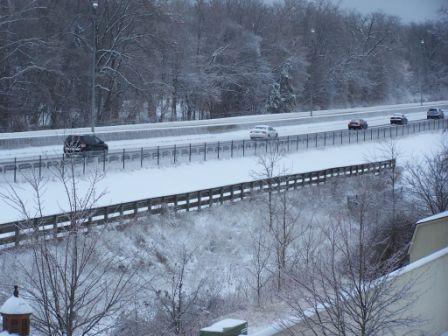Winter Driving

Driving through Snow and Ice
Here's the deal...winter weather is dangerous and the best advice you can ever get is simply don't drive in it. If your out on the roads and an unexpected storm blows in, then it's worth it to find a hotel and hunker down for the night (don't take unnecessary chances). Try not to leave your house until the snow plows and salt trucks have had a chance to do their work, and allow tons of extra time to reach your destination. And most importantly...don't drive like a NASCAR driver on the ice!
It never hurts to pack some emergency supplies if you absolutely have to drive in these conditions. Throw an extra blanket, road flairs, extra clothing, fire starting kit, and a flashlight into your car.
If you must drive in snowy conditions, make sure your car is prepared and that you know how to handle road conditions.
It's helpful to practice winter driving techniques in a snowy, open parking lot, so you're familiar with how your car handles. Consult your owner's manual for tips specific to your vehicle.
Driving safely on icy roads
- If your car likes to skid in the ice (or if your not sure because you've never tried it before) then toss some sandbags in your trunk. The extra weight will dramatically increase your car's performance in these conditions.
- Decrease your speed and leave yourself plenty of room to stop. You should allow at least three times more space than usual between you and the car in front of you.
- Apply the brakes gently to avoid skidding. If your wheels start to lock up, ease off the brake.
- Turn on your lights to increase your visibility to other motorists.
- Keep your lights and windshield clean.
- Use lower gears to keep traction, especially on hills.
- Don't use your cruise control or overdrive on icy roads.
- Be especially careful on bridges, overpasses and infrequently traveled roads, which will freeze first. Even at temperatures above freezing, if the conditions are wet, you might encounter ice in shady areas or on exposed roadways like bridges.
- Don't pass snow plows and sanding trucks. The drivers have limited visibility, and you're likely to find the road in front of them worse than the road behind.
- Don't assume your vehicle can handle all conditions. Even four-wheel and front-wheel drive vehicles can encounter trouble on winter roads.
- Keep your eyes on the road at all times. Avoid unnecessary phone calls, fidgeting with the radio, or looking at maps.
If your rear wheels skid...
- Don't Stomp on your brakes!
- Take your foot off the accelerator.
- Steer in the direction you want the front wheels to go. If your rear wheels are sliding left, steer left. If they're sliding right, steer right.
- If your rear wheels start sliding the other way as you recover, ease the steering wheel toward that side. You might have to steer left and right a few times to get your vehicle completely under control.
- If you have standard brakes, pump them gently.
- If you have anti-lock brakes (ABS), do not pump the brakes. Apply steady pressure to the brakes. You will feel the brakes pulse — this is scary but it really is normal.
If your front wheels skid...
- Don't stomp on your brakes!
- Take your foot off the gas and shift to neutral, but don't try to steer immediately.
- As the wheels skid sideways, they will slow the vehicle and traction will return. As it does, steer in the direction you want to go. Then put the transmission in "drive" or release the clutch, and accelerate gently.
If you get stuck...
- Do not spin your wheels. This will only dig you in deeper.
- Turn your wheels from side to side a few times to push snow out of the way.
- Use a light touch on the gas, to ease your car out.
- Use a shovel to clear snow away from the wheels and the underside of the car.
- Pour sand, kitty litter, gravel or salt in the path of the wheels, to help get traction.
- Try rocking the vehicle. (Check your owner's manual first — it can damage the transmission on some vehicles.) Shift from forward to reverse, and back again. Each time you're in gear, give a light touch on the gas until the vehicle gets going.
Sources: National Safety Council, New York State Department of Motor Vehicles, Washington State Government Information & Services, Weather.com
The bottom line is when you start to skid...SLOW DOWN and DON'T HIT YOUR BRAKES!
You can explore other travel options to avoid winter driving.

